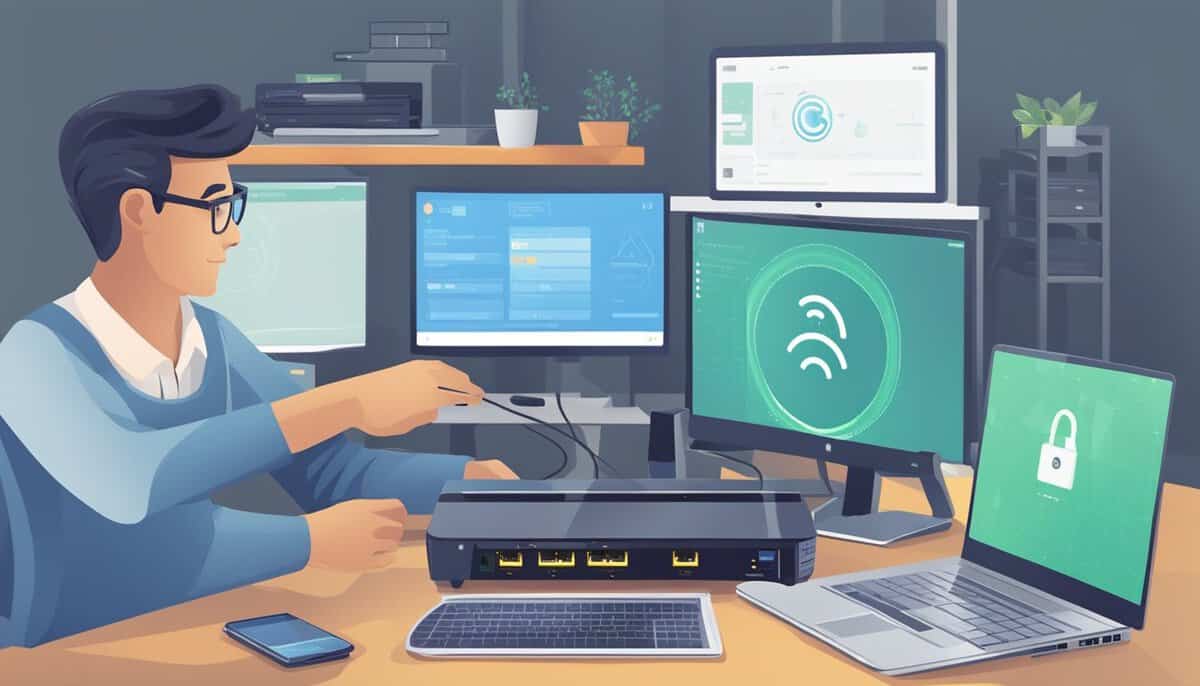Setting up a guest WiFi network in your home is a smart move for improving both security and convenience.
By creating a separate network for your visitors, you protect your primary network from potential risks.
Guests can access the internet without touching any of your personal devices or data.
A guest WiFi network not only enhances security but also makes life easier for your visitors. They get easy, isolated access to the internet without the complications of logging into your main network. Plus, it’s simple to manage which devices are connected to this network.
To set this up, you’ll need to tweak some settings on your router. Find the guest network settings in your router’s admin panel and create a unique SSID and password. Some routers even allow you to share access with a QR code, making it even simpler for your guests to connect.
Key Takeaways
- Creating a guest WiFi network improves security and convenience.
- Guests can access the internet without affecting your main network.
- Setting up requires configuring your router’s guest network settings.
Why a Separate Guest Network?
Setting up a separate guest network offers several advantages. It enhances security and privacy, improves network performance, and provides convenience for both guests and hosts.
Benefits for Security and Privacy
A separate guest network isolates your primary network. This means visitors can access the internet without touching your personal devices. It protects your smart home gadgets, computers, and data from potential malware or cyberattacks.
Keeping your data private is crucial. A guest network ensures that visitors can’t snoop on your personal files or inadvertently cause a data breach. This layer of security is a simple yet effective way to maintain peace of mind.
Improving Network Performance
When guests connect to their own network, it can help improve your primary network performance. Your main network resources won’t get bogged down by extra devices. This separation allows for more efficient bandwidth use.
Having a guest network means better performance for activities like streaming, gaming, or working from home. It ensures that both your family’s devices and your guests’ devices get the necessary bandwidth without interfering with each other.
Convenience for Guests and Hosts
A guest network is convenient for visitors because it provides them with easy internet access. They won’t need complex passwords or to navigate through settings. Just give them the guest Wi-Fi name and password, and they’re good to go.
For hosts, it simplifies network management. You can monitor and control the guest network separately. If anything goes wrong, it won’t affect your primary network. Plus, some routers offer the option to share access with a QR code, making it even easier for guests to connect.
Planning Your Guest WiFi Setup
Creating an efficient guest WiFi network involves understanding your network needs, selecting appropriate hardware, and ensuring you have dependable internet service. Planning these aspects carefully will help you set up a smooth and secure guest WiFi experience.
Determining Network Requirements
First, think about how many devices will connect to your guest network. If you’re hosting parties or events, there might be a lot more connections. Aim for a router that can handle high bandwidth to avoid slowdowns.
Consider whether you’ll need multiple access points to cover larger areas. Think of where your guests will be. Are they mostly in the living room or spread across different areas? Finally, decide on your wireless settings like the network name (SSID) and password for security.
Choosing the Right Hardware
When picking out hardware for your guest WiFi, a good router is essential. Look for a router with a strong range and the ability to handle multiple devices smoothly. If your space is large, you might consider adding extra access points to ensure good coverage.
Make sure your router supports guest networks. Some models, even budget ones, come with this feature built-in. Updating your firmware can also improve performance and security, so it’s a good practice to keep it current.
Sourcing Reliable Internet Service
You’ll want reliable internet service that can support multiple devices on a separate network. Contact your internet service provider to discuss your needs. Some ISPs may offer packages that are more suited for high-bandwidth use.
Check your current plan’s speed and bandwidth. If necessary, upgrade to a higher-tier plan. This helps make sure your guest network doesn’t impact your primary network’s performance, providing a seamless browsing experience for everyone.
Ensuring your service is stable and fast enough will keep your guest WiFi network efficient and hassle-free.
Configuring the Guest Network Settings

To set up your guest WiFi network, you need to focus on the network name and password, Wi-Fi security options, and access restrictions. Each of these parts is crucial for creating a secure and manageable guest network.
Setting Up Network Name and Password
The first step is to choose a network name, also known as the SSID, and a strong password. Log in to your router’s admin panel by entering its IP address into a web browser. Usually, this address can be found on a sticker on the router itself.
Once logged in, navigate to the Guest Network settings. Here, choose an SSID that makes it clear this is a guest network, like “Guest_WiFi_YourName.”
Next, create a strong password that includes a mix of letters, numbers, and symbols. For example, “Guest1234!” is not enough; opt for something like “Gue$tW1f!2024”. This password should be different from your main network to ensure better security.
Adjusting Wi-Fi Security Options
Securing your guest network is an essential step. In the security settings of your router, select WPA3 if available; it’s currently the most secure encryption method for wireless networks. If WPA3 isn’t an option, WPA2 is usually good enough.
Make sure to disable SSID broadcast if unnecessary. This hides your network from casual users looking for WiFi. While this isn’t a foolproof method of enhancing security, it adds a layer of protection.
Enable the firewall on your guest network to monitor and control incoming and outgoing traffic. A firewall helps block unauthorized access, keeping your primary network safe.
Implementing Access Restrictions
Access restrictions help you control what guests can and can’t do on your network. Look for options like parental controls or access control lists in your router settings.
Restrict access to only certain websites or limit the amount of bandwidth guests can use. This is especially useful if you don’t want guests hogging all the internet speed.
Consider setting up a separate subnet for your guest network. Doing this can help isolate guest traffic from your primary network, adding an extra layer of security. This way, even if someone gets through the guest network, they still can’t access sensitive information on your main network.
By following these steps, you’ll configure a secure and efficient guest WiFi network.
Connecting Devices and Managing Access

Setting up a guest Wi-Fi network not only enhances security but also facilitates smooth connection for your guests. You’ll want to ensure a seamless experience, manage who can connect, and keep the network secure.
Guiding Guests to Connect Seamlessly
Make it easy for guests to connect by providing clear instructions. Share the guest Wi-Fi name (SSID) and password either verbally, on a card, or via a QR code. For tech-savvy guests, a QR code is handy as they can simply scan it with their phones to join the network.
Steps to Share Access:
- Create a unique network name and password.
- Print the details on a small card.
- Generate a QR code for quick scans.
By preparing ahead, your guests can connect their phones, smart TVs, and other devices without hassle.
Monitoring and Troubleshooting Connectivity
Keep an eye on connected devices to ensure optimal performance. Use your router’s web interface or a network management app to see who’s connected. This helps in identifying any unauthorized devices.
If guests face issues:
- Check Wi-Fi settings: Confirm they’ve chosen the correct SSID and entered the right password.
- Restart devices: Sometimes a simple reset can solve many problems.
- Router reboot: Rebooting the router can clear out minor glitches.
By monitoring connectivity and troubleshooting promptly, you ensure a smooth experience for your guests.
Maintaining a Secure and Updated Network
Regular updates are crucial for network security. Ensure your router’s firmware is up-to-date to benefit from the latest security patches and technology improvements.
Best Practices:
- Firmware Update: Check your router’s settings or manufacturer’s website for updates.
- Password Changes: Periodically update the guest Wi-Fi password to prevent unauthorized access.
- IoT Security: Be cautious of IoT devices; they can be gateways for vulnerabilities.
By following these steps, you maintain control over the network and provide a secure environment for your guests.
Don’t forget to review your security settings regularly to keep your network safe from potential threats.
Optimizing the Guest Wi-Fi Experience

Let’s make sure your guest Wi-Fi is not only secure but also provides a top-notch experience. Focusing on signal strength, customized features, and staying up-to-date with technology can really make a difference.
Ensuring Strong Signal Strength and Coverage
To keep your guest Wi-Fi running smoothly, the signal strength must be strong and consistent throughout your home. Position your router centrally to cover all areas. If your router’s range is limited, consider using Wi-Fi extenders or mesh network systems.
Use the 2.4 GHz band for broader coverage and the 5 GHz band for faster speeds in a smaller area. Check for any physical obstructions like walls or large furniture that could block the signal and adjust the placement accordingly.
Customizing Features for Various Use Cases
Customize your guest Wi-Fi settings based on how you expect it to be used. Set bandwidth limits to ensure your main network doesn’t get bogged down. You can also create time limits or schedules, letting guests access Wi-Fi only during certain hours.
Enable a VPN for extra privacy and ensure they can’t access your main devices. In hospitality settings like hotels or cafes, offering easy-to-understand login instructions and consistently good performance can boost satisfaction.
Staying Current with Tech Trends and Updates
Technology evolves quickly, and keeping your guest Wi-Fi up-to-date matters. Regularly check for firmware updates from your ISP or router manufacturer to improve network performance and security. Newer routers often come with advanced features like guest network isolation and better hardware for performance.
Follow tech blogs or updates from trusted sites to stay informed of the latest tech trends. This way, your guest Wi-Fi remains reliable and secure, meeting the demands of new devices and applications effectively.

